The Apple iPad Air 2 Review
by Joshua Ho on November 7, 2014 9:30 AM EST- Posted in
- Tablets
- Apple
- Mobile
- iOS
- ipad Air 2
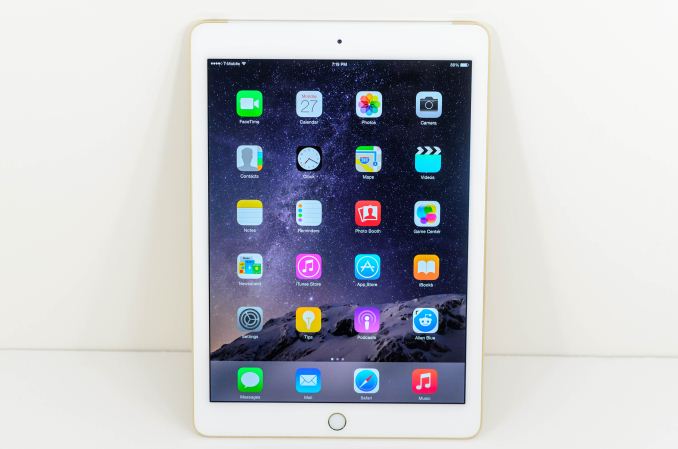
As we approach the holidays, Apple has launched a new iPad as expected. As one might expect from the name, the iPad Air 2 is more of an evolution of the original iPad Air than a clean-sheet design. This doesn’t mean that there’s little to talk about though, as Apple has gone a long way to improve every aspect of the iPad Air with this iteration. However, with this generation Apple seems to be under fire as Google attempts to push into the premium tablet space with the Nexus 9.
Without question though, the iPad line defines what an ARM-based tablet is. The iPad Air 2 is undoubtedly a part of this lineage with its focus on a large touch-screen display. This level of design minimalism is responsible for at least part of the original reaction to the tablet as a “large phone”. However, by virtue of its sheer size there are new possibilities opened up in terms of content consumption and even content creation. In the basic definition of a tablet, the iPad Air 2 definitely fits. There’s a new SoC, more RAM, a better display lens, new cameras, and an even thinner design, but all of these things don’t change the fact that this is a 9.7” display that can only be interacted with through a touchscreen. In the interest of saving space and time, I’ve included a spec sheet below to cover all bases.
| Apple iPad Air 2 | |
| SoC | 3x 1.5 GHz CPU A8X |
| RAM/NAND | 2GB LPDDR3 + 16/64/128GB NAND |
| Display | 9.7" 2048x1536 IPS LCD |
| Network | WiFi only or 2G / 3G / 4G LTE SKU |
| Dimensions | 240 x 169.5 x 6.1 mm, 437g WiFi, 444g LTE |
| Camera | 8MP Rear Facing with F/2.4 aperture, 1.3MP FFC |
| Battery | 7340 mAh (27.62 Whr) |
| OS | iOS 8.x |
| Connectivity | 802.11a/b/g/n/ac + BT 4.1, USB2.0, GPS/GNSS |
As with any other mobile device, one of the most immediate impressions one can form is that of design. This may be one of the most important areas as well, because every mobile device is constantly held or otherwise handled. These devices tend to be deeply personal as well, which means that there’s a great deal more emphasis on industrial design than a desktop tower that gets shoved into a dark corner for five years at a time.
To this end, the iPad Air 2 does quite well. The design is definitely separate from the iPhone 6 line, as the metal chamfer remains, but the form continues to be quite pleasing. On the front face of the tablet, we see a single 1.2MP camera, the display, and the home button which has TouchID built in. The glass is flat, which makes it seem noticeably different from the iPhone 6 line in that regard as it meets the chamfered edge of the back cover rather than making a seamless curve. The radius of the curve is also noticeably different as a result, simply curving in towards the center of the device rather than curving out of the device. If anything, this does make the iPad Air 2 feel a bit thicker in the fingers but the device overall is still incredibly thin.
Speaking of the back cover, there’s really almost nothing to speak of on the back cover. There’s the 8MP camera and a microphone hole, but not much else other than the large plastic RF window on the top edge of the tablet. The curve of the sides does make it seem like there’s a great deal more on the back cover though. Other than the RF window, there’s a power button and 3.5mm jack on the top of the tablet. Next to the power button are the volume buttons, but curiously no mute/lock rotation switch for this generation. I suspect that the reasons for this deletion are primarily due to user confusion, although my experiences are purely anecdotal in this regard. Finally, along the bottom of the device we see the Lightning port and two speaker grilles.
Overall, the design of the iPad Air 2 is impressive. The thin feel is really quite impressive when compared against other devices, but the weight no longer feels quite as incredible as the original iPad Air when compared to the iPad 4.
Outside of the physical design, Apple has also included a selection of two cases which include the smart cover and case, which are mostly unchanged from the previous generation except to fit the iPad Air 2. I don’t have much to complain about here although the smart case has a bit more flex on the sides than I’d like. The smart cover does have enough strength in the magnets to hold the tablet by the cover, although I wouldn't recommend doing this.


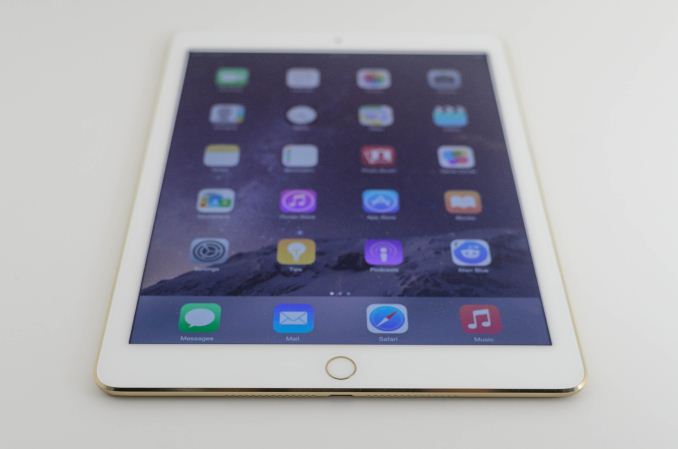
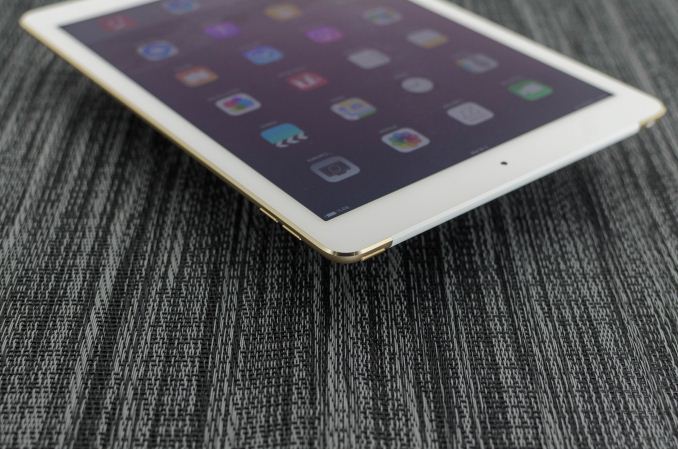
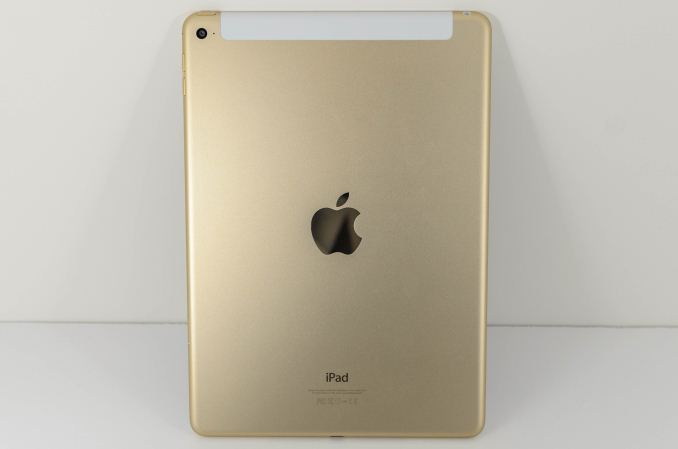

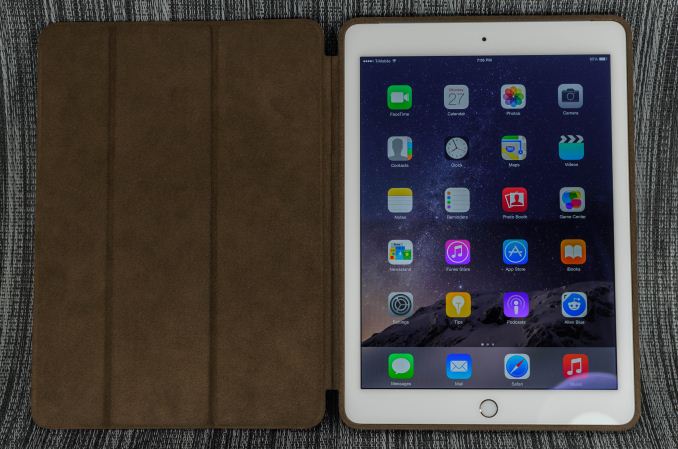








226 Comments
View All Comments
Sushisamurai - Friday, November 7, 2014 - link
You should mention in the design segment, that there is a consequence with the thinness. I was playing some media (TV show, the 100, gotham), and due to the thinness, with the volume turned up, the iPad would reverberate/vibrate due to the audio output.In my opinion, the loss of a few millimetres was not worth this trade off, as my iPad 2 never shook when playing music or movies from its speakers at full blast.
chaosbloodterfly - Friday, November 7, 2014 - link
My old HP touchpad used to do that, but the sound quality was really good (and loud) for a tablet (like comparable to your average bluetooth speaker box things).Sushisamurai - Friday, November 7, 2014 - link
I noticed you added it in the misc section. It is still a design consideration IMO. Tomato tomato. It's my only gripe with the iPad Air 2. That and maybe ios8 - it's still a little buggy for me.KPOM - Friday, November 7, 2014 - link
Another thorough review by AT. I think software should be the next major focus for Apple with the iPad. The CPU and GPU power are getting to the point where the iPad could replace a laptop, provided the software were there. Maybe we'll see true multitasking and split window displays if and when the iPad Pro comes out with a 12+" screen. That third CPU core must be there for more than just games.steven75 - Friday, November 7, 2014 - link
I think they are heading this way.-iPad Pro rumors
-IBM deal
-MS Office (iWork since 2011, but still)
-iCloud Drive and support for third party cloud storage in the native file picker.
And now beefed up hardware that makes more sense for laptop-type usage.
esterhasz - Friday, November 7, 2014 - link
Good points and you're probably right.But I still think that multitasking is great on a desktop/laptop not so much because of the windows, but because of the control scheme: using the dominant hand for the pointer (like on touch) and the other for focus switching (like between programs) is just so insanely efficient. Bringing in the second hand for doing something simply does not work that fluidly on a touch device. And that would ultimately hamper the direction you're describing.
Or I may simply suck at touching.
ABR - Friday, November 7, 2014 - link
It's amusing to me when people talk about needing to multitask on tablets. 90% of the people I see using 24" desktops zoom every window they use to full-screen. It's actually HARDER to read the long lines of text or mouse around large expanses of blank space this way, but people like to focus on one thing at a time I guess. I tend to be more of the "use virtual space to organize the workflow" type when I've got that kind of real estate, but I rarely have the desire to do more than switch between fullscreen apps on a tablet.Still, we may see Apple add some kind of split-screen mode if only because people think they want it, like they gave us the comically unwieldy iPhone 6+.
Crackhour - Saturday, November 8, 2014 - link
I have the samsung 10.1 2014 edition and I never split screen. I like to focus on one screen so it seems. Apple seem to know this is reason it hasn't adopted the split screen my opinion. It just negates you the choiceStealthX32 - Friday, November 7, 2014 - link
Uhm, what planet do you live on where Apple cares about anything but the consumer market? Hmm, instead of giving developers incentives to write on OSX/iOS, let's give U2 $100 million dollars instead. Yeah, that's what will advance them as a company.ams23 - Friday, November 7, 2014 - link
Josh, don't you think it is a bit misleading to show a chart with a long-term fps of 46fps for Shield tablet in the GFXBench T-Rex Onscreen test when it was able to maintain an fps of ~ 55fps for the first 100 (!) continuously looped runs of the test (which represents nearly two hours of continuous use!)? I don't see how the 46fps is a realistic number for comparison. Even the GFXBench website lists a long-term median performance result of ~ 55fps for Shield tablet.Also note that Tegra K1 has higher render quality in GFXBench than A8X and any other ultra mobile SoC, so it is doing more work in that test.
A8X is a fantastic SoC and iPad Air 2 is an awesome tablet, but do note that iPad Air 2 has some significant performance-reducing throttling in both Geekbench 3 and 3dmark Ice Storm Unlimited. With long-term testing, the performance of A8X drops by ~ 30% in Geekbench 3 and drops by ~ 15% in 3dmark Ice Storm Unlimited: http://www.notebookcheck.net/Apple-iPad-Air-2-A156...
(It is my understanding that Shield tablet has virtually no CPU/GPU throttling due to use of the internal magnesium plate to dissipate heat).
On a side note, here is what OlegSH had to say about the GFXBench 3.0 T-Rex Onscreen test: "It's strange to see GLBenchmark 2.7 test as battery life test in GFXBench 3.0
Kishonti uses low precision FP16 shaders for T-Rex by default, that has quite noticeable impact on picture quality, just look at MP(medium precision) PSNR, hence the perfect MP PSNR for K1, looks like K1 doesn't support FP16. This combined with small amount of geometry, very simple shaders, lots of blending make this test perfect fit for tiled architectures. I don't believe lifetime results will stay the same once they move to Manhattan as power test".